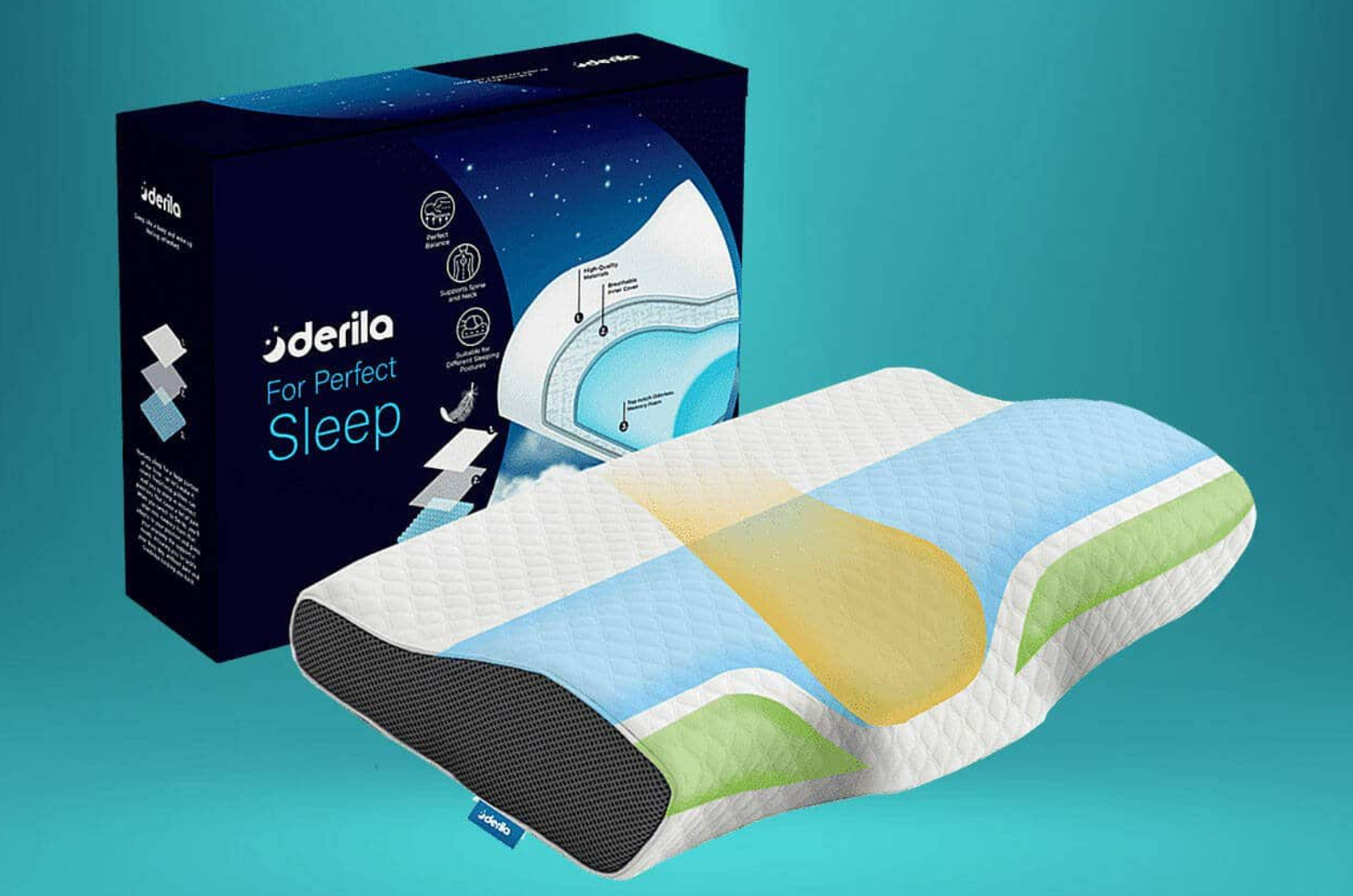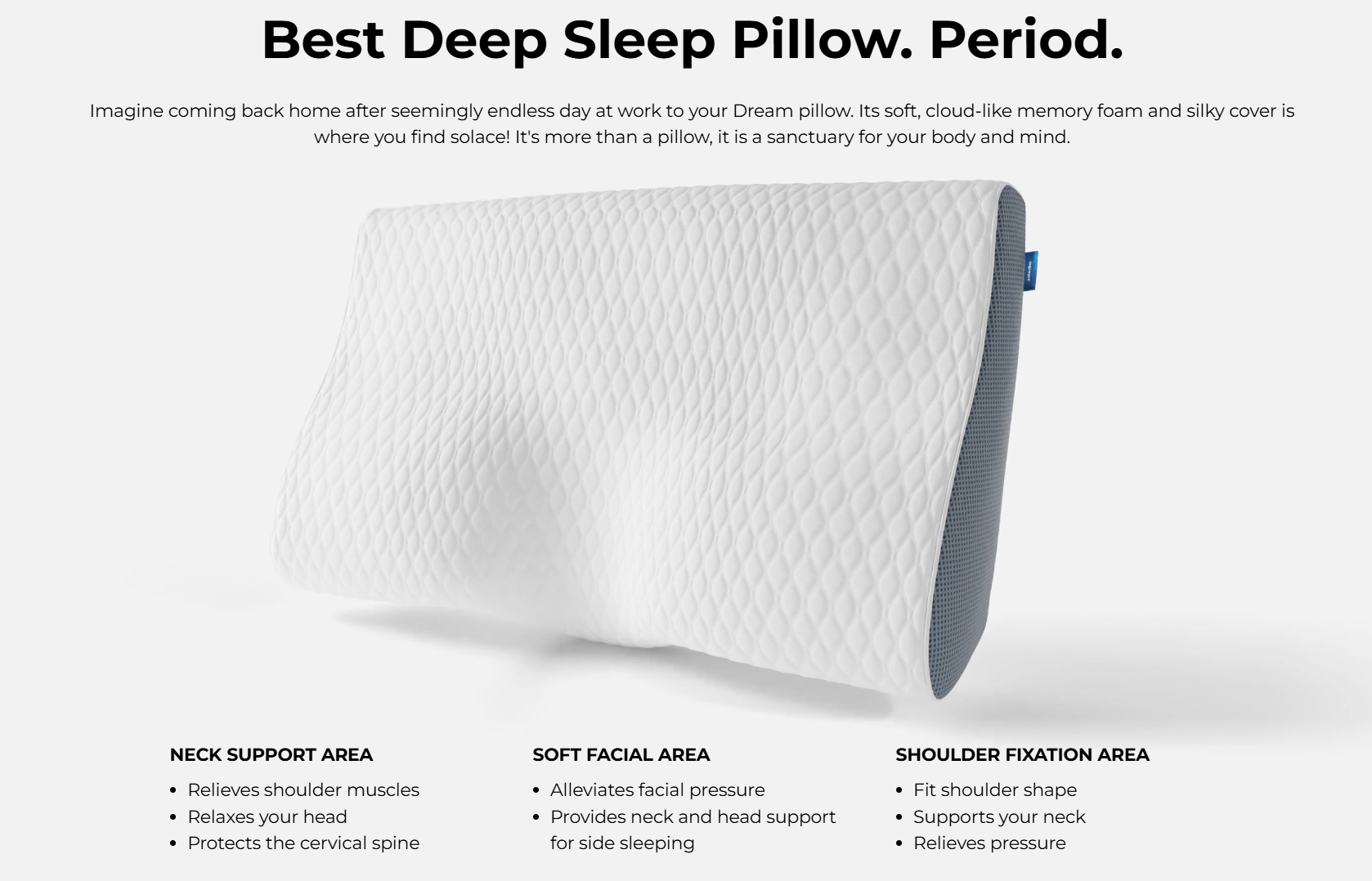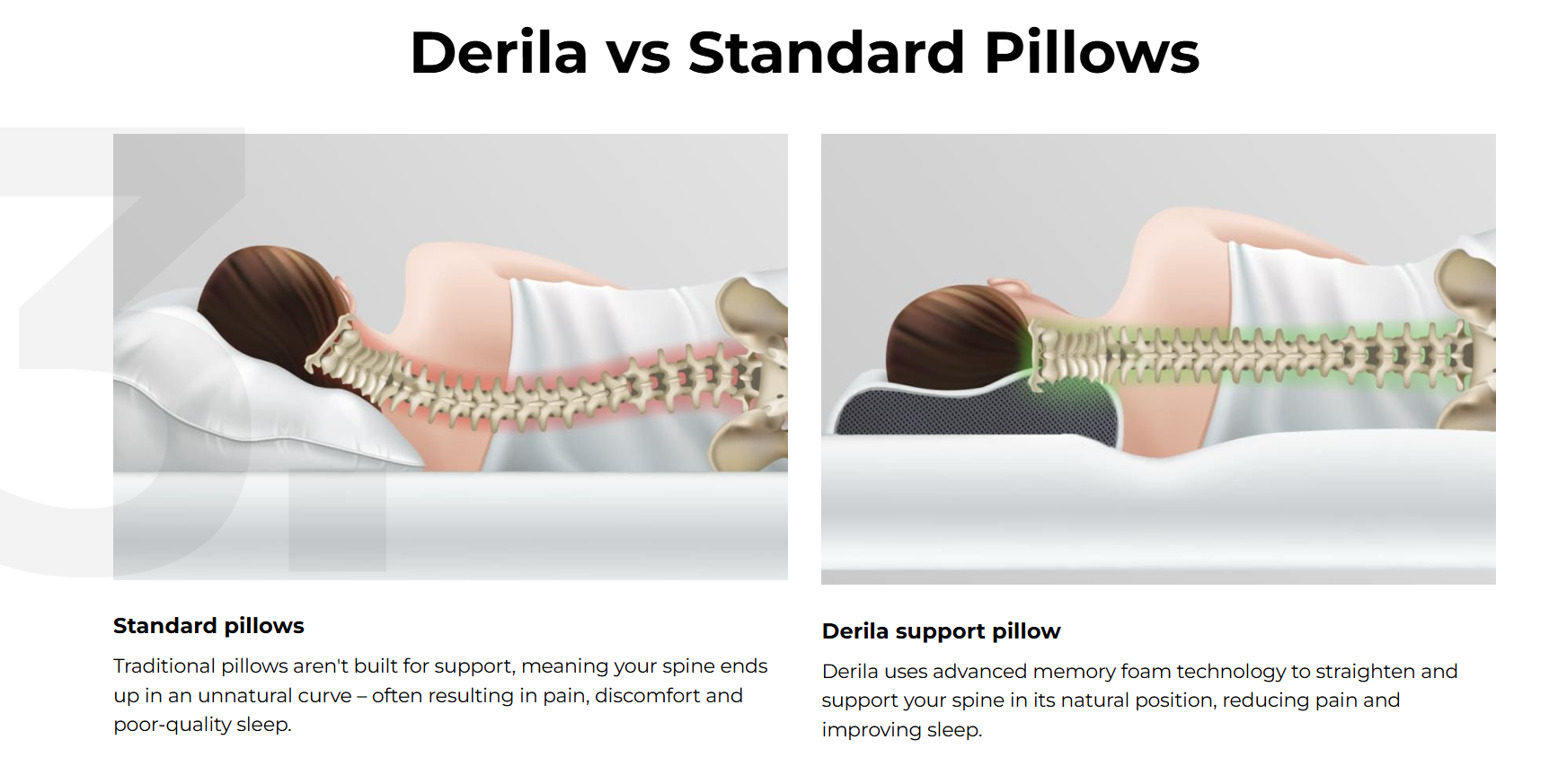 Do you wake up in the morning with a sore neck, stiff shoulders, and exhausted? You feel like did not get any rest at all. People blame the hectic schedule and even aging, but the real culprit is the Pillow. Yes, you read that right. Sleeping in the wrong position can lead to pain, suffering, and exhaustion. Poor quality pillow, blocks the blood flow, making your body tense. To solve this problem, Derila has come up with a unique Derila ERGO Memory Foam Pillow. This Derila Pillow review will help you get all the right information to make an informed decision. Click Here to visit the Official Website for Derila ERGO Memory Foam Pillow
Do you wake up in the morning with a sore neck, stiff shoulders, and exhausted? You feel like did not get any rest at all. People blame the hectic schedule and even aging, but the real culprit is the Pillow. Yes, you read that right. Sleeping in the wrong position can lead to pain, suffering, and exhaustion. Poor quality pillow, blocks the blood flow, making your body tense. To solve this problem, Derila has come up with a unique Derila ERGO Memory Foam Pillow. This Derila Pillow review will help you get all the right information to make an informed decision. Click Here to visit the Official Website for Derila ERGO Memory Foam Pillow
What is Derila Pillow?
Derila Ergo Pillow is an ergonomic memory foam pillow designed to improve sleep. It improves the blood flow and relaxes the shoulder and neck muscles. You wake up refreshed after a long night of sleep. Some may even refer to it as an orthopaedic memory foam pillow. Click Here to visit the Official Website for Derila Pillow..
Derila pillows are made of high-density memory foam, contoured to the shape of the neck and shoulders to provide tailored support. It eases pressure on tendons, relaxes joints, and allows for smooth blood flow. Derila puts minimum pressure on your body.
Product Specification
- Brand: Derila
- Color: White
- Size: Standard (19.7”*11.8”*3.9”)
- Fill Material: Premium Memory Foam
- Shape: Butterfly
- Special Feature: Removable Cover
- Recommended Use: For Sleeping
- Age: Adults
- Item Weight: 58 pounds
- Manufacturer: Derila
- Derila Pillow Price:
- 1 pillow costs $59.99
- 2 Pillows cost $99.98
- 3 pillows cost $137.97
- 4 Pillows Cost $159.96
- Money Back Support: 30-Days
- Item Launch date: September 20, 2022
- Visit the Official Website to buy or read more….
Who would benefit from the Derila Ergo Pillow?
People who would benefit the most are those who are experiencing poor sleep and various issues. These issues could be:
- People Experiencing Tense Shoulder and Neck pain: wrong sleep posture can twist the tendons and can cause soreness and, in a few cases, stiffness. If you feel pain in the morning when you wake up, it’s time to change your pillow.
- Misaligned Side Sleepers: Side sleepers are more likely to experience misalignment of the neck and shoulder. It can be prevented easily with the right pillow. This misalignment can cause extreme stiffness.
- Stomach Sleepers: Stiff neck: Some say it is one of the worst sleeping positions. When you sleep on your stomach, you twist your neck for a longer time. This strain on neck muscles can cause soreness and fatigue.
- People With Sensitive Skin: Regular pillows are a dust magnet; they collect everything, from dust to mites. It can lead to an allergic reaction and a runny nose. Disrupting the sleep.
- People who want to experience deep sleep for long: It’s not necessary for you to have a problem using the Derila pillow. Regular people can use it to enhance the sleep experience.
5 Benefits of Derila Pillow
- Pressure relief and pain reduction: Research suggests that a memory foam pillow can support the neck, reduce neck pain, and shoulder stiffness. The Derila pillow can contour and evenly distribute pressure. It is beneficial for people with neck pain and mild arthritis.
- Motion Isolation: The viscoelastic properties of the Derila pillow allow it to absorb head and neck movements. This is beneficial, especially if you share a bed with someone. Your motion is less likely to affect the other person.
- Spinal Alignment: The Derila pillow is molded according to the natural curve of our upper spine and neck. It helps keep your neck in a neutral position when you are sleeping. This proper alignment prevents morning pain and stiffness.
- Heat Responsiveness: Derila pillow uses the 3rd-generation gel-particle memory foam. It is able to distribute heat to your body. You are less likely to sweat at night.
- Pressure Distribution: Derila Ergo Pillow is molded according to the natural curve of your body. It is the least likely to put any pressure on your muscles and tendons. The reduced pressure reduces the neck pain and discomfort.
The mechanism behind Derila Pillow
The uniqueness of the Derila pillow lies in its memory foam. Memory foam is made of Viscoelastic polyurethane foam. This material was developed by NASA in 1960 to provide cushion for astronauts during takeoff and reentry.
Over the years, independent labs have been able to improve the design and create a memory foam available to the general masses.
So, how does Derila Memory Foam Pillow work?
When pressure is applied to memory foam, it deforms and contours itself as per the pressure points. Unlike regular pillows, it doesn’t bounce back immediately. It takes time to bounce back. Allowing for heat dissipation and shock absorption.
It is elastic, so it does regain its original shape. Memory foam is temperature and pressure-sensitive. Your body heat helps get the perfect contour of the head and neck.
The open cell structure allows for breathability and slow recovery. Memory foam in the Derila pillow is dense; it does not collect dust, pollen, or mites. Keeping it clean and hypoallergenic.
7 Unique Features of Derila Pillow
- Skin and hair friendly: It has hypoallergenic properties. It doesn’t collect dust and mites. It will keep your skin smooth and hair untangled.
- Machine Washable: It can be washed easily in a machine. For a longer life, we suggest hand washing with cold water.
- Adaptive to temperatures: It absorbs body heat and dissipates, reducing the sweat formation on the pillow. It keeps you cool and comfortable.
- Odorless: It has no smell. It has a very neutral smell that you will not notice.
- Advanced Memory foam: The memory foam is 3rd generation. It is advanced in structure. It has gel particles.
- Anti-Snore: In a few cases, it has helped people reduce snoring.
- Butterfly Wing Support: There are many products that claim to have butterfly wing support. This one has the true butterfly wing design.
Pros and Cons of Using Derila Memory Foam Pillow
Pros:
- Hypoallergenic
- Removable cover
- Reasonable price
- Durable
Cons:
- Internet Exclusive
- Pricey for a few people
- Limited availability
Consumer Reports & Complaints (Derila memory foam pillow reviews)
The overall reviews of the Derila pillow are mixed. Few people are happy with the product, while others claim it to be useless. Few people experienced improvement in sleep, while others experienced no change. Moreover, the pillow quality, functionality, and neck support also have mixed opinions. Some of the Derila Pillow Reviews are:
- Linda S. from the United States says, “I didn’t expect much from the pillow. Sleep quality remains unchanged. However, pain is reduced. First impression was so so. But after using it, I could feel the changes; I felt less stiffness in my nec”
- Joseph Kriegel from the United States says, “Derilla pillow is far better than the regular pillow. I was having trouble sleeping due to a neck injury, and it helped me a lot.”
Do ergonomic Derila Memory Foam Pillows actually work?
Yes, Ergonomic pillows do work to provide a better sleep experience. Derila pillow is one such example. These pillows can reduce neck muscle tension and shoulder stiffness. They are easy to clean and last for a long time.
Derila Pillow price
- 1 pillow costs $59.99
- 2 Pillows cost $99.98
- 3 pillows cost $137.97
- 4 Pillows Cost $159.96
Where to buy Derila Pillow? (Derila Pillow Website)
The best place to buy a Derila Pillow. It is the official website. This is an internet-exclusive product. It is available on the internet. Avoid dupes by buying from its official website.
Final Verdict
A good night’s sleep is a necessity. Regular pillows may not work for everyone. If you experience stiffness in your neck and exhaustion when you wake up, it’s time to switch to the Derila ERGO Memory Foam Pillow. This multifunctional pillow can relieve neck soreness and shoulder stiffness. It has multiple benefits. Moreover, the price is reasonable. So, anyone can buy it.
Frequently Asked Questions
Is Derila Pillow for sleep apnea?
Derilla Pillow can help with many issues related to sleep apnea, one of which is. However, the success rate with sleep apnea is low.
What is the Derilla Pillow’s Amazon availability?
Yes, it is available on Amazon. We recommend buying from the official website.
Is it suitable for travelling?
Yes, you can carry it anywhere. It is lightweight.
Is Derila Pillow Legit and safe?
Yes, Derila pillows are legit and safe. You can order them from its official website.
Disclaimer & Copyright
The content on AmericanPainSociety.org is provided for general informational purposes only and should not replace professional medical advice, diagnosis, or treatment. We make no guarantees of accuracy, completeness, or timeliness. Users rely on the information at their own risk. Always consult qualified professionals for healthcare decisions.
© 2025 American Pain Society. All rights reserved. No part of this website may be reproduced, distributed, or transmitted in any form or by any means without prior written permission.


